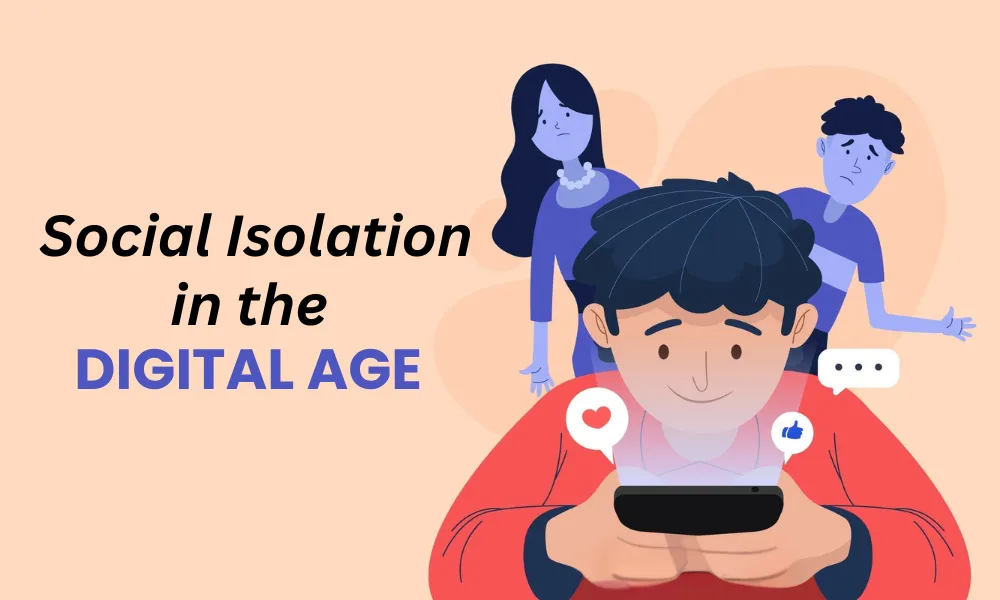Social Isolation in the Digital Age

In today’s connected world, staying in touch seems easier than ever, yet many still feel lonely. Hours spent online often replace real conversations, leaving people with fewer meaningful bonds. This growing pattern of online social isolation affects emotional health and makes genuine human connections harder to build and maintain.
A recent report reveals that 1 in 6 people worldwide is affected by loneliness, with severe consequences on health and well-being. Shockingly, loneliness is linked to an estimated 100 deaths every hour—adding up to more than 871,000 deaths annually. These numbers highlight why addressing social isolation is urgent.
When Isolation Becomes Concerning
Spending time alone occasionally is normal, but constant withdrawal from friends, family or hobbies is an early sign of depression. People may avoid calls, social gatherings or even daily routines. These behavioural changes are signals that social isolation and mental health struggles might be closely linked.
The Role of Technology in Disconnection
While social media offers instant communication, excessive reliance can create a false sense of closeness. Scrolling through updates without genuine engagement often deepens feelings of being left out. This shift highlights how digital life stress contributes to emotional exhaustion and increases vulnerability to depression.
Emotional Clues to Watch Out For
Some key emotional signs include:
- Sudden mood swings without clear triggers
- Irritability over minor issues
- Constant feelings of sadness or emptiness
- A growing sense of hopelessness
Physical Symptoms That Signal Trouble
Social isolation doesn’t only affect emotions—it can also show up physically. Unexplained fatigue, irregular sleep patterns, changes in appetite and frequent headaches are common. When combined with long periods of digital disconnection, these signs may indicate that an individual’s overall well-being is being impacted.
Impact on Work and Studies
Social withdrawal doesn’t stop at home—it affects productivity too. Declining focus, missed deadlines, and lack of interest in tasks can reflect digital age loneliness. For students and professionals, these patterns highlight how prolonged isolation interferes with both academic growth and career development.
How Relationships Are Affected?
When isolation builds, communication with loved ones suffers. People may appear distant, unresponsive, or overly reliant on digital conversations instead of face-to-face interactions. This weakens bonds and can leave individuals feeling unsupported, further deepening the link between social isolation and mental health struggles.
Breaking the Cycle of Isolation
Early action makes it easier to overcome isolation. Simple steps like reconnecting with friends, engaging in offline hobbies, or setting screen-time boundaries can reduce digital life stress. Building small, consistent routines that encourage human connection is one of the best ways to restore balance and improve well-being.
Why Professional Guidance Matters?
Sometimes personal efforts are not enough. A psychologist or counselor can provide structured strategies to address online social isolation and identify the early signs of issues like depression. Therapy helps build coping skills, restore confidence, and encourage healthier digital–offline balance in everyday life.
How Mindsy Can Support You?
Mindsy connects individuals with licensed psychologists who understand the challenges of digital age loneliness and social withdrawal. The platform offers online consultations, interactive sessions and guided self-help tools that make professional support approachable and easy to access, no matter where you are.
With flexible access through the Mindsy app, individuals can book sessions, monitor progress, and receive timely guidance without barriers of distance or time. By bridging experts and those in need, Mindsy ensures continuous support that encourages healthier connections, reduces digital life stress, and builds a more balanced lifestyle in today’s fast-paced world.
FAQ’S
1. What are the early signs of social isolation?
Early signs include irritability, mood swings, reduced interest in daily activities, avoiding calls or social gatherings, and spending long hours alone. These behaviours suggest increasing disconnection from meaningful relationships.
2. How does digital age loneliness affect mental health?
Excessive online time often replaces face-to-face interactions, leading to feelings of emptiness, disconnection, and low emotional well-being. This lack of genuine connection can impact confidence and self-worth.
3. Can online social isolation cause physical health problems too?
Yes. Social isolation can show up physically as fatigue, poor sleep, appetite changes, frequent headaches, and even lowered immunity over time.
4. How can someone spot if a loved one is struggling with digital life stress?
Look for changes like avoiding social gatherings, irritability, lack of focus at work or school, relying only on digital chats and appearing distant in relationships.
5. What are simple ways to break the cycle of social isolation?
Reconnecting with friends, setting screen-time limits, engaging in hobbies, maintaining routines, and spending time outdoors can help reduce isolation and improve mental health.
Data Source - https://www.who.int/news/item/30-06-2025-social-connection-linked-to-improved-heath-and-reduced-risk-of-early-death
